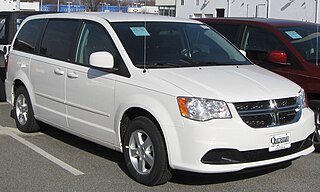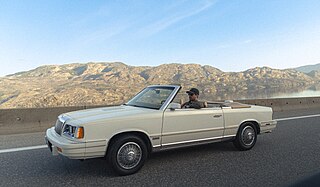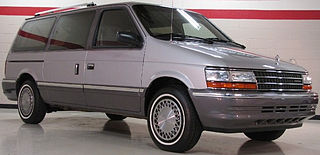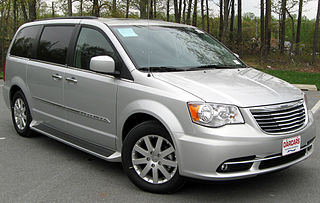
Minivan is a car classification for vehicles designed to transport passengers in the rear seating row(s), with reconfigurable seats in two or three rows. The equivalent classification in Europe is MPV or M-segment.
Dodge is an American brand of automobiles and a division of Stellantis North America, based in Auburn Hills, Michigan. Dodge vehicles have historically included performance cars, and for much of its existence Dodge was Chrysler's mid-priced brand above Plymouth.

Plymouth was a brand of automobiles produced by Chrysler Corporation and its successor DaimlerChrysler. The brand was launched in 1928 to compete in what was then described as the "low-priced" market segment that was dominated by Chevrolet and Ford. It became a high-volume seller for the automaker until the late 1990s. Plymouth cars were marketed primarily in the United States. The brand was withdrawn from the marketplace in 2001. The Plymouth models that were produced up to then were either discontinued or rebranded as Chrysler or Dodge.

The Ford Windstar is a minivan that was produced and sold by Ford. The replacement for the Ford Aerostar, the Windstar adopted the front-wheel drive configuration of the Chrysler minivans. From the 1995 to 2007 model years, three generations of the model line were sold, with the final generation renamed as the Ford Freestar.

The Dodge Caravan is a series of minivans that was manufactured by Chrysler from the 1984 to 2020 model years. The Dodge version of the Chrysler minivans, the Caravan was marketed as both a passenger van and a cargo van. For 1987, a long-wheelbase Dodge Grand Caravan was introduced. Produced in five generations across 36 model years, the Dodge Caravan is the second longest-lived Dodge nameplate.

(1986 Chrysler Lebaron convertible)

The Chrysler minivans are a series of minivans that have been produced and marketed by the American automaker Chrysler since the 1984 model year. Currently in its sixth generation, the model line is marketed worldwide, primarily in North America and Europe. Introduced as the Dodge Caravan and Plymouth Voyager, the Chrysler minivans have been marketed under a variety of nameplates under the Chrysler, Plymouth, Dodge, and Ram brands; through the use of rebadging, the model line has also been marketed under the Lancia and Volkswagen brands.

Plymouth Voyager is a nameplate for a range of vans that were marketed by the Plymouth division of Chrysler. From 1974 until 1983, the Voyager was a full-size van, sold as the counterpart of Dodge Sportsman. Starting with the 1984 model year, the Voyager was marketed as one of the new Chrysler minivan, along with the Dodge Caravan. As a minivan, there were three generations of the Voyager from 1984 until 2000. Following the closure of the Plymouth division in 2000, the Voyager was marketed under the Chrysler brand as a lower-trim version of the Chrysler Town & Country through 2003.

The Chrysler Voyager is a minivan produced by the Chrysler division of Stellantis. In the current lineup, it is positioned as the lower-end Chrysler minivan, having replaced the Dodge Grand Caravan in 2020, below the Chrysler Pacifica.

The Chrysler Town & Country is a minivan that was manufactured and marketed by Chrysler from 1990 to the 2016 model years. The third Chrysler minivan introduced in North America, the Town & Country adopted its nameplate from the flagship Chrysler station wagon line, adopting its exterior woodgrain trim as a design feature for several generations.

The Ford Aerostar is a range of vans that was manufactured by Ford from the 1986 to the 1997 model years. The first minivan produced by Ford, the model line was marketed against the Chevrolet Astro/GMC Safari and the first two generations of the Chrysler minivans. Introduced shortly before the Ford Taurus, the Aerostar derived its name from its slope-nosed "one-box" exterior.

The Chevrolet Lumina APV is a minivan that was produced by the Chevrolet division of General Motors. The first front-wheel drive minivan sold by Chevrolet, the Lumina APV was sold in a single generation from the 1990 to 1996 model years. Marketed alongside the Pontiac Trans Sport and Oldsmobile Silhouette, the Lumina APV competed against the Dodge Grand Caravan/Plymouth Grand Voyager, the extended-length Ford Aerostar, and the Mazda MPV.

The Dodge Ram Van is a range of full-size vans that were produced by Chrysler Corporation from the 1971 to 2003 model years. Replacing the Dodge A100, the Ram Van transitioned to a front-engine drivetrain configuration. Mostly offered as a cargo van and a passenger van, the model line was also initially offered as a cutaway van chassis.

The Mitsubishi Chariot is an automobile manufactured and marketed by Mitsubishi from 1983 to 2003. It is a small multi-purpose vehicle (MPV). Based on the SSW concept car first exhibited at the 23rd Tokyo Motor Show in 1979, the MPV derives its nameplate from chariots used by the ancient Greek and Roman empires.
The Ultradrive is an automatic transmission manufactured by Chrysler beginning in the 1989 model year.
In the context of the automobile industry, downsizing is a practice used to transition vehicles from one size segment to another. Commenced during the Malaise era, downsizing is done in response to consumer and government demands influencing vehicle design. As vehicle product lines completed their model cycles, automobile manufacturers developed the next generation of a vehicle with a smaller exterior footprint to allow for weight reduction and increased fuel economy, using a shortened wheelbase and body length.

The RS-platform Chrysler minivans are a short- and long-wheelbase passenger minivans marketed by Chrysler from model years 2001–2007, as the fourth generation Chrysler minivans, heavily revised versions of their predecessors, the NS minivans.

The second-generation Chrysler minivans are a series of minivans that were manufactured and marketed by Chrysler Corporation in North America and Europe from 1991 to 1995. Officially designated the AS platform by Chrysler, the second-generation minivans were an extensive revision of the first-generation chassis and body. As before, passenger and cargo configurations were sold by Dodge, Plymouth, and Chrysler divisions. The first minivans offered with driver-side airbags and with optional integrated child safety seats, the second-generation Chrysler minivans offered all-wheel drive as an option for the first time; a manual transmission would be offered for the last time in the North American market.

The third-generation Chrysler minivans are a series of passenger minivans that were marketed by the Chrysler Corporation from the 1996 to 2000 model years. The first ground-up redesign of the model lines since their introduction, designers added a further degree of divisional identity between the Plymouth Voyager, Dodge Caravan, and Chrysler Town & Country. In a notable change, the cargo van was discontinued, with all examples sold as passenger vans. Coinciding with the retirement of the Plymouth brand during 2001, this is the final generation marketed as the Plymouth Voyager.

The RT-platform Chrysler minivans are a series of passenger minivans marketed by Chrysler starting in model year 2008, the fifth in six generations of Chrysler minivans. Depending on the market, these vans were known as the Dodge Grand Caravan, Chrysler Town & Country, Chrysler Grand Voyager, Lancia Voyager, Ram Cargo Van, and the Volkswagen Routan, a modified version sold by Volkswagen in North America. Only long wheelbase models were offered with the Dodge Journey replacing the short wheelbase model. While most versions were discontinued in 2016 with the launch of the Chrysler Pacifica minivan, the Grand Caravan remained in production until 2020. It was replaced by the sixth generation Chrysler Voyager, a new entry-level model based on the existing Chrysler Pacifica minivan.






























